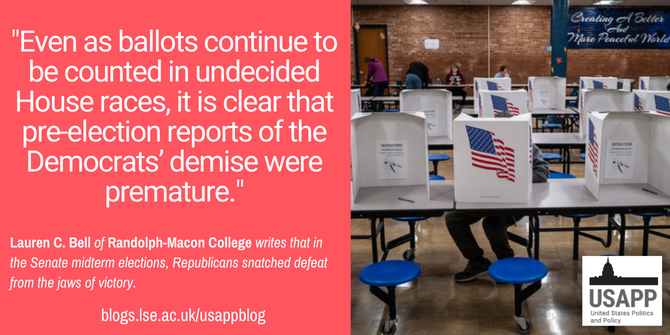 In this year’s midterm elections, the Democratic Party defied the expectations of many to maintain control of the US Senate and lose far fewer US House seats than polls had predicted. Lauren C. Bell takes a close look at the Democrats’ Senate election performance, writing that despite many factors that could have worked against them – such as high inflation and President Biden’s poor approval ratings – the importance of abortion as an issue in the wake of the overturning of Roe vs. Wade by the Supreme Court, the turnout of younger voters, and the Republicans’ poor candidate quality can help to explain the Democrat’s success.
In this year’s midterm elections, the Democratic Party defied the expectations of many to maintain control of the US Senate and lose far fewer US House seats than polls had predicted. Lauren C. Bell takes a close look at the Democrats’ Senate election performance, writing that despite many factors that could have worked against them – such as high inflation and President Biden’s poor approval ratings – the importance of abortion as an issue in the wake of the overturning of Roe vs. Wade by the Supreme Court, the turnout of younger voters, and the Republicans’ poor candidate quality can help to explain the Democrat’s success.
- Our mini-series, ‘The 2022 midterms‘, explores aspects of the midterm elections at the presidential, Senate, House of Representative and state levels, and also reflects on what the results will mean for US politics moving forward. If you are interested in contributing, please contact Rob Ledger (ledger@em.uni-frankfurt.de) or Peter Finn (p,finn@kingston.ac.uk).
On Monday, November 7th, with the 2022 congressional midterm elections just hours away, the Democrats had little reason to be hopeful. Election Day would be a “nightmare scenario” for the party, with the possibility of losing not just the House of Representatives, but the Senate too. But when the dust settled, Democrats have maintained their control of the Senate and pending the results of a December 5 runoff election in Georgia may be poised to improve their numbers in the chamber. Meanwhile, Republicans in the Senate are now divided over who should lead them and pointing fingers at who’s to blame for their lackluster midterm showing.
The Run-Up to November 8
The road to the 2022 Senate midterms began in March, when states began holding primary elections to select their candidates for the November 8 general election. Thirty-four Senate seats were up for election this year, but just 13 were widely considered to be competitive. Throughout the primary season, Democrats meddled successfully in Republican primaries, including those to decide the Republican Senate nominees in New Hampshire and Colorado. Their strategy was to amplify right-wing extremist candidates who would find it difficult to win a majority of votes in the general election.
Then in June, the US Supreme Court officially overturned Roe v. Wade (1973), the nearly 50-year-old precedent guaranteeing women a constitutional right to abortion through the end of the second trimester of pregnancy. Democrats anticipated that negative public reaction to the decision, coupled with a set of extremist Republican candidates, would buoy their chances to defy the “ironclad rule” that the President’s party loses seats in a midterm election.
But, then gasoline prices spiked. So did consumer prices, generally, while consumer confidence declined. Meanwhile, President Joe Biden’s approval rating plummeted as the election got closer.
Republicans thought they could seize the moment. They downplayed abortion. Their campaign ads put the economy front-and-center and accused Democrats of being soft on crime—lines of attack that have historically worked for them. Democrats tried to keep the focus on abortion, but as the campaign season drew to a close, both partisan and nonpartisan pre-election modeling showed that Republicans were more likely than not to gain control of the Senate. Media analyses projected not just a Republican wave but a ‘red tsunami.’ On Election Day, Democrats braced for defeat.

“Election Day 2022” (CC BY 2.0) by Phil Roeder
Election Day
As the polls closed on Election Day, several Senate races were called relatively quickly for Republicans: Florida incumbent Marco Rubio resoundingly won his race. Shortly after, in Ohio, Hillbilly Elegy writer J.D. Vance defeated sitting member of Congress Tim Ryan. Then in North Carolina, Ted Budd defeated his opponent, Cheryl Beasley. Later in the evening, Wisconsin’s Senate race was called for incumbent Ron Johnson over challenger Mandela Barnes.
But then the tide turned. Colorado’s Democratic incumbent Michael Bennet won his race. New Hampshire was called for incumbent Senate Democrat Maggie Hassan. In the small hours of the morning on November 9, the Pennsylvania Senate race was called for Democrat John Fetterman and the Washington Senate race was called for Democrat Patty Murray. As the ballots were counted over the next several days, incumbent Arizona Democrat Mark Kelly won. Eventually—late in the evening on Saturday, November 12—so did the current Nevada Democratic Senator Catherine Cortez Masto.
Even without knowing the results of the one remaining race—the Georgia contest between incumbent Democrat Raphael Warnock and Republican challenger, football star Hershel Walker—Democrats will return to the Senate with, at a minimum, control of a chamber split 50-50, since Vice-President Kamala Harris, a Democrat, holds the tie-breaking vote. But if Warnock successfully fends off Walker in the December 5th runoff between the two men, that will give the Democrats outright control of the chamber and blunt worries about defections from the Democrats’ agenda by West Virginia Senator Joe Manchin.
How it happened
Three explanations for the Democrats’ surprising success on November 8 stand out: the durability of abortion as an important issue, the turnout of younger voters, and candidate quality among Republicans.
Despite Republican beliefs that the abortion issue would fade away or that it would be blunted by the flagging economy, exit polls showed that the US Supreme Court’s June decision in Dobbs v. Jackson Women’s Health Organization had a galvanizing effect on voters—especially women. Abortion was particularly important, as well, for first-time and younger voters.
Those younger voters are also an important part of the story of the 2022 congressional midterms. Although a slightly higher proportion of voters aged 18-29 turned out for the 2018 midterms than appear to have turned out for the 2022 midterms, younger voters supported Democrats by wide margins.
And it appears that the Republicans’ nomination of far-right or Donald Trump-endorsed Republican candidates, especially those who continued to claim that the 2020 presidential election was stolen, simply did not pay off the way Republicans expected. Mehmet Oz in Pennsylvania, Blake Masters in Arizona, Adam Laxalt in Nevada, and Don Bolduc in Maine all lost their races. Only in Ohio and North Carolina did Trump-backed candidates win.
Campaign missteps mattered as well. Oz, for example, when asked about abortion during his debate with John Fetterman, said that decisions about abortion should be left up to “women, doctors, [and] local political leaders.” The Masters campaign put out several ads that left swing voters calling him crazy. Trump’s barnstorming campaign in the final weeks of the campaign likely did more harm than good for many of the Republicans he stumped for.
The takeaway
Concerns about the state of American democracy have been mounting for the last several years; the January 6, 2021 insurrection at the U.S. Capitol brought into stark relief the extent to which efforts by political leaders to undermine democracy have had a destabilizing effect in the U.S. In that sense, democracy itself was on the ballot on November 8. And voters in most places signaled that they’re not willing to give it up just yet.
Even as ballots continue to be counted in undecided House races, it is clear that pre-election reports of the Democrats’ demise were premature. And, instead of rolling back President Joe Biden’s recent policy successes and preventing him from governing, Republicans can, at best, look forward to passing legislation in the House only to see it ignored by Senate Democrats—who are likely to be focused on confirming as many of Biden’s judicial nominees as they can over the next two years, in hopes of continuing to reshape the federal judiciary.
- Please read our comments policy before commenting.
- Note: This article gives the views of the author, and not the position of USAPP – American Politics and Policy, nor the London School of Economics.
- Shortened URL for this post: http://bit.ly/3EBIvAM






